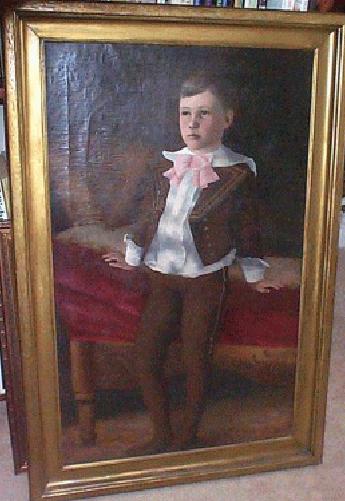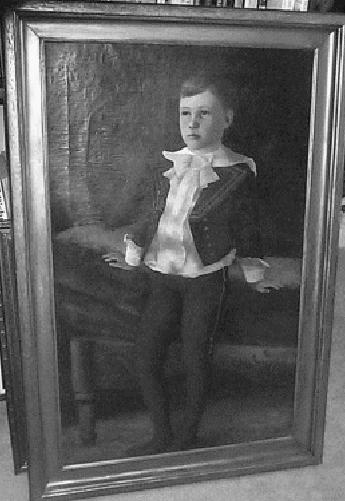
Little Lord Fauntleroy Suits: Classic Period Colors (1885-95)

Figure 1.--This Fauntleroy suit was done in brown with a detailing perhaps influenced by a sailor suit. In such instances just what is a Fauntlery suit becomes a bit blurred. The ruffled collar and cuffs with the small jacket certainly give it an overall Fauntleroy appearance. Click on the image for a fuller discussion of this boys's outfit.
|
Fauntleroy suits were made in many colors and materials and with a variety of features and embelishments. The classic Fauntleroy suit was black or dark blue. Later other dark
colors appeared like burgandy or forrest green. We know suits were made in these colors because many wealthy families had portraits painted. Also fashion magazines during the period noted these colors, notably the velvet suits were usually dark colors. The suits
done in satin, however, were usually lighter colors. Color is an interesting topic. We know that Fautleroy suits were made in black and the above noted dark colored velvets. What is not known, however, is the relative popularity of the different colors. I had assumed that the black suits were the primary colors. This is probably because I was viewing the
photographic record which was, of course, all black and white photography. I know of no historical works discussing this question.
Photography
Many of the images of Little Lord Fauntleroy suits are Carte de Viste or cabinent cards taken in photographic studios. They are often very high quality images. Even so, it very difficult to make out the colors of the suits involved. Many if no most seem to be black. It is possile to tell from the shading that not all were black. Determining the actual shades is impossible.
Fauntleroy suits were made in many colors and materials and with a variety of features and embelishments. The classic Fauntleroy suit was black or dark blue. Later other dark
colors appeared like burgandy or forrest green. We know suits were made in these colors because many wealthy families had portraits painted. Brown seems an especially popular choice, although we are still assessing the relative popularity of the differing colors and shades. Also fashion magazines during the period noted these colors, notably the velvet suits were usually dark colors. Many catalogs provide details as to the colors and materials in which these suits were made. We do not yet know if these different colors varied over time or among countries.

Figure 2.--Note the difficultuy in assessing color from a black and white image.
|
Material
The fabric or material could affecvt the color of the suit. Fashion magazines during the period noted these colors, notably the velvet suits were usually dark colors. The suits
done in satin, however, were usually lighter colors. Color is an interesting
topic. We know that Fautleroy suits were made in black and the above
noted dark colored velvets.
Popularity
What is not known, however, is the relative
popularity of the different colors. I had assumed that the black suits were the primary colors. This is probably because I was viewing the photographic record which was, of course, all black and white photography. I know of no historical works discussing this question.
Accessory Colors
There appaers to be no clear pattern in the choice of colors for the bows the boys wore with their Fauntleroy suits. Note the pink bow with a brown suit here (figure 1). With the bows, the mothers appraoched their decission with abandon. Sashes were less common and we are not yet sure of color selection. As regards the long stockings, dark colors were normally chosen diring the clasic period. In many cases the stockings were chosen to match the suit. Note the boy here wears brown stockings to match his brown suit.
Paintings
Although photographers were replacing many artists, especially naive artists, by the 1880s, there are some paintings which show us the color of the suits. Painted portraits that we know of include the following information on color:
The 1880s: A painting by Millais on loan during 1998 to a London
Museum shows Master
Robert Rankin who looks to be about 10 or 11 years in an elaborate
forrest green velvet Fautleroy suit with lace collar
and cuffs, long uncvurled hair, and a beret-like cap.
The 1890s: A 1896
Sargent portrait shows an American family, Mrs. Carl Meyer and her children, with the boy wearing a grey Fauntleroy suit.
Garments
As Fauntleroy suits were indeed suits, the knee pants normally matched the jacket. American boys normally wore long stockings of the same color, but not almways the same shade as the suit. French boys wore long stockings less commonly, but I am not yet sdure what color their stockings were.
Christopher Wagner

Fauntleroy Related Pages:
[Return to the Classic Fauntleroy suit page]
[Return to theMain Fauntleroy page]
[Edwardian Fauntleroy suits]
[Final Fauntleroy period]
[Fauntleroy dresses]
[Lace collars]
[Vivian Benett]
[Fauntleroy patterns]
Other Related Pages:
[Dresses]
[Kilts]
[Smocks]
[Pinafores]
[Sailor Hats]
[Blouses]
[Ring Bearers]
[Long hair]
[Ringlet curls]
[Hair bows]
[Bangs]
[Collars]
[Bows]
Navigate the Boys' Historical Clothing Web Site:
[Introduction]
[Activities]
[Biographies]
[Chronology]
[Clothing styles]
[Countries]
[Bibliographies]
[Contributions]
[FAQs]
[Glossaries]
[Satellite sites]
[Tools]
[Boys' Clothing Home]
Created: November 27, 1998
Last updated: September 30, 2002




